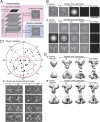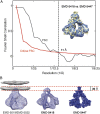Reply to Subramaniam, van Heel, and Henderson: Validity of the cryo-electron microscopy structures of the HIV-1 envelope glycoprotein complex
- PMID: 24350339
- PMCID: PMC3831492
- DOI: 10.1073/pnas.1316666110
Reply to Subramaniam, van Heel, and Henderson: Validity of the cryo-electron microscopy structures of the HIV-1 envelope glycoprotein complex
Conflict of interest statement
The authors declare no conflict of interest.
Figures


Comment on
-
Subunit organization of the membrane-bound HIV-1 envelope glycoprotein trimer.Nat Struct Mol Biol. 2012 Sep;19(9):893-9. doi: 10.1038/nsmb.2351. Epub 2012 Aug 5. Nat Struct Mol Biol. 2012. PMID: 22864288 Free PMC article.
-
Molecular architecture of the uncleaved HIV-1 envelope glycoprotein trimer.Proc Natl Acad Sci U S A. 2013 Jul 23;110(30):12438-43. doi: 10.1073/pnas.1307382110. Epub 2013 Jun 11. Proc Natl Acad Sci U S A. 2013. PMID: 23757493 Free PMC article.
-
Finding trimeric HIV-1 envelope glycoproteins in random noise.Proc Natl Acad Sci U S A. 2013 Nov 5;110(45):E4175-7. doi: 10.1073/pnas.1314353110. Epub 2013 Oct 8. Proc Natl Acad Sci U S A. 2013. PMID: 24106301 Free PMC article. No abstract available.
-
Structure of trimeric HIV-1 envelope glycoproteins.Proc Natl Acad Sci U S A. 2013 Nov 5;110(45):E4172-4. doi: 10.1073/pnas.1313802110. Epub 2013 Oct 8. Proc Natl Acad Sci U S A. 2013. PMID: 24106302 Free PMC article. No abstract available.
-
Avoiding the pitfalls of single particle cryo-electron microscopy: Einstein from noise.Proc Natl Acad Sci U S A. 2013 Nov 5;110(45):18037-41. doi: 10.1073/pnas.1314449110. Epub 2013 Oct 8. Proc Natl Acad Sci U S A. 2013. PMID: 24106306 Free PMC article.
References
Publication types
MeSH terms
Substances
Grants and funding
LinkOut - more resources
Full Text Sources
Other Literature Sources
Medical

